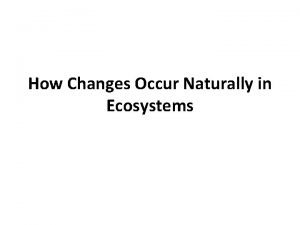Land Cover Land Use Change Ecosystems Mapping and

- Slides: 1

Land Cover Land Use Change & Ecosystems Mapping and Modeling of Invasive Plant Species in Kenya Training Consultations Needs Assessment Beta Testing Stakeholder Mapping Service Planning Dev. Consultation/Needs Assess. Output 1 Operationalization Outcome Use Case / Highlights Problem specification Kenya has had several invasions of alien species that have had negative impacts on biodiversity, agriculture and human development. For instance, prickly pear (Opuntia spp) outcompetes native plants, precludes grazing and browsing near it, and inhibits the proliferation of indigenous species. The Northern Kenya Rangelands in the recent decades have experienced increased infestation by various invasive plant species shrinking forage space available for both livestock and wildlife. Deforestation, climate change, and degradation have led to the loss of biodiversity and have allowed for the proliferation of invasive species. Fieldwork Theory of Change To Achieve Sustainability Assumptions: Availability of funds, Skills, Collaboration Service Use Case: Inputs: Stakeholder Engagements, Data collection, Technical exchanges Outputs: Mobile application for data offline data collection, Maps, Training materials Goal Outcomes: More people trained on mapping and predicting the distribution of invasive species, Improved capacity in prioritizing, and planning of the conservation areas, Improved access to invasive species distribution data, Improved and efficient data collection, archiving and retrieving process. Data on mapping, monitoring and assessment of invasive species can provide governments with insight into how the poor and vulnerable are affected by the loss and degradation of biodiversity and ecosystems due to the spread of the invasive species. This will directly or indirectly help in achieving the millennium development goal 1: Eradicate extreme poverty and hunger: Livelihood strategies and food security of the poor often depend directly on healthy ecosystems and the diversity of goods and ecological services they provide. Impact: Information on distribution of invasive species would assist in managing rangeland ecosystems within Laikipia Samburu region and in assessing implications of climate-induced changes on future land use patterns. Maps on distribution of invasive species will be used by NRT, LWF, county governments and other NGO’s in allocating resources to eradicate the invasive species and also in soliciting for funds from donors. Key stakeholders Decision makers: National and County Governments Users: Northern Rangeland Trust, Laikipia Wildlife Forum, Kenya Wildlife Service. Beneficiaries: Northern Rangeland Trust, Laikipia Wildlife Forum, Kenya Wildlife Service Special audiences: Local community conservation organizations, Local communities Science Collaborations, Earth Observations, Models, and Methods Earth Observations / Models / Methods Fig. 1: Local community members use a mobile application in data collection (Source: Business Daily News; url https: //www. businessdailyafrica. com/news/Pastoralists-godigital/539546 -4544716 -f 7 nany/index. html Peter Hertz, chief executive officer (CEO) of the Laikipia Wildlife Forum (LWF) noted that the maps are effective tools for assessing impact of eradication strategies. “The maps produced so far, provide us with baseline data on where the invasive plants currently are. We can therefore do a before and after assessment to gauge progress made in eradicating them. ” RCMRD/SERVIR E&SA plans to out scale the use of Invasive Species Mapper (ISM) application in the data collection process to support regional governments and conservation organizations in tracking extents of invasive species. Additionally, the SERVIR small grants Selected Indicators / Metrics: awarded to a partner organization (Laikipia Wildlife Forum) will further support the data collection and capacity development efforts. The service involves mapping and modelling of the invasive species using occurrence data, Looking forward which is then applied to a predictive model to identify where suitable environments for invasive Through the leadership of county government of Laikipia, a consortium of different institutions has been formed to drive different agenda in reducing the effects of invasive species especially Opuntia species including: species are likely to occur under current and future climate conditions under Representative Climate Pathways (RCPs) 2. 6 and 8. 5. The RCP 2. 6 represents the lowest Greenhouse Gas (GHG) concentration pathway, whereas RCP 8. 5 represents the extreme GHG concentration • Monitoring and Mapping subcommittee led by RCMRD and supported by Laikipia Wildlife Forum, Loisaba Conservancy, KWS, World Agroforestry Centre, Space for Giants) pathway. The current distribution of the invasive plant species is sampled using an Android based application through a citizen science approach and modelled into current and future • Policy Strategy and Action Plan sub committee led by Laikipia County Government, World Vision, LWF, Northern Rangeland Trust, National Drought Management Authority. scenarios using a time-series of vegetation indices from Moderate Resolution Imaging Spectroradiometer (MODIS) satellite, Elevation (SRTM) and World. Clim data. Immediate Next Steps Fig. 2: Invasive Species Mapper Visualization Tool Fig. 3: The current and potential distribution under RCP 2. 6 and RCP 8. 5 for the years 2050 and 2070 for A. reficiens • Enterprise Management Control subcommittee led by GSD Innovations.

